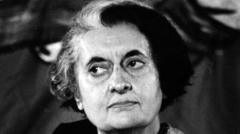
Whispers of a Presidential Shift: Centralization Efforts Within Indira Gandhi's Inner Circle
In the annals of Indian political history, the period surrounding Indira Gandhi's premiership remains a subject of intense scrutiny and debate. While her leadership is often lauded for decisive actions and strategic foresight, concerns have also been raised regarding the concentration of power during her tenure. Emerging from historical records and scholarly analyses are accounts suggesting that influential figures within her administration actively promoted a transition to a presidential system of governance.
The Presidential System Proposal: A Shift in the Balance of Power
The core of this proposed shift lay in the ambition to centralize executive authority, potentially at the expense of established democratic institutions. A presidential system, as envisioned by these aides, would have fundamentally altered the relationship between the executive, the legislature (Parliament), and the judiciary. The existing parliamentary structure, with its emphasis on collective responsibility and accountability to the elected representatives of the people, would have been superseded by a model granting the President significantly expanded powers.
Key Aims and Motivations:
- Streamlining Decision-Making: Proponents argued that a presidential system would enable faster and more efficient decision-making, unencumbered by the perceived complexities and delays inherent in parliamentary procedure.
- Enhanced Executive Authority: The proposed system aimed to provide the executive branch with greater autonomy and control over policy implementation, theoretically leading to more decisive governance.
- Circumventing Political Obstacles: Some advisors believed that a presidential system would provide a mechanism to bypass parliamentary opposition and judicial challenges, allowing for the swift execution of government initiatives.
Potential Ramifications for Parliament and the Judiciary
The potential consequences of adopting a presidential system during this period were significant, particularly concerning the roles of Parliament and the judiciary.
Parliament: A Diminished Role?
Under a presidential model, the Parliament's legislative authority could have been substantially curtailed. The ability of the legislature to effectively scrutinize and hold the executive accountable might have been weakened, potentially leading to a reduction in its overall influence on policy-making. The dynamics of legislative debate and amendment processes could have been significantly altered, limiting the scope for diverse viewpoints and potentially marginalizing opposition voices.
The Judiciary: Independence Under Threat?
Concerns were also raised regarding the potential impact on the judiciary's independence. A more centralized executive power, combined with a weakened Parliament, could have created an environment where the judiciary faced increased pressure to align its rulings with the government's agenda. The ability of the courts to act as a check on executive power, a cornerstone of democratic governance, might have been compromised.
Arguments Against the Shift
While the prospect of a presidential system was actively considered within certain circles, it faced considerable opposition from within the government and throughout Indian society. Critics argued that such a shift would undermine the fundamental principles of parliamentary democracy and create opportunities for authoritarianism.
- Erosion of Democratic Principles: Opponents emphasized that a presidential system could lead to a concentration of power in the hands of a single individual, potentially eroding the checks and balances essential for a healthy democracy.
- Risk of Authoritarianism: Concerns were raised that a powerful executive, unconstrained by a strong Parliament and an independent judiciary, could abuse its authority and suppress dissent.
- Disruption of Established Norms: Critics argued that fundamentally altering the system of governance would destabilize the political landscape and create uncertainty, particularly during a period of significant social and economic challenges.
Conclusion: A Road Not Taken
Ultimately, the proposal to transition to a presidential system did not come to fruition. While the precise reasons for its abandonment remain a subject of historical debate, the concerns raised regarding its potential impact on democratic institutions undoubtedly played a significant role. The episode serves as a reminder of the ongoing tension between the desire for efficient governance and the imperative to safeguard the fundamental principles of democracy, including the separation of powers and the protection of individual liberties. The legacy of this period continues to inform contemporary debates about the balance of power and the future of Indian democracy.
```